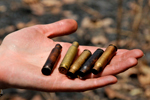
A monk at Wat That Thong temple in Bangkok During a Buddhist merit-making ceremony to pray for the tens of thousands of elephants poached annually. Photo by: © WWF Thailand.
Buddhist leaders prayed for slaughtered African elephants in Bangkok, Thailand last week, reports WWF. During a special merit-making ceremony, often reserved for the recently deceased, Buddhist monks, abbots, and leaders prayed for the tens-of-thousands of elephants that have been killed for their ivory tusks. Bangkok is currently hosting an international meeting of the Convention on International Trade in Endangered Species (CITES), where the elephant crisis is being discussed.
“Having prestigious leaders from the Buddhist community in Thailand lead this ceremony here, which is usually practiced for a family member who has passed away, emphasizes that we are all interdependent and part of one great web of life,” Phansiri Winichagoon, country director of WWF-Thailand, said.
Elephant poaching is decimating populations across Africa with experts warning that 25,000 elephants are being killed annually. No where is the slaughter worse than in the Congo Rainforest, home of the African forest elephant (Loxodonta cyclotis). New research estimates that 60 percent of the world’s forest elephants have been killed in the last ten year alone. Poachers, often connected to criminal syndicates, have also become more brazen. Some parks have seen whole elephant herds slaughtered, including babies.
Elephants are highly-intelligent and emotional animals, forming strong bonds with family members. In addition, elephants play a large ecological role in the environment, including dispersing many rainforest seeds.
The ceremony in Thailand was also meant as an educational opportunity for the nation’s many Buddhists: a recent investigative article by National Geographic argued that much of the demand for ivory is coming from Buddhists and Catholics seeking religious items carved out of the material. In fact, recently, a temple in Sri Lanka—the Sri Dalada Maligawa Buddhist Temple—has lobbied the government for a seized shipment of 359 elephant tusks. Buddhism as a religion, however, stresses that all is sacred. The first of the Buddha’s five precepts concerns abstaining from the taking of sentient life, which applies to all animals, including elephants. In addition, Buddhists practice ahimsa, which means to do no harm to any living creature.
The merit-making ceremony today also featured a massive chalk drawing of an African elephant by Dutch artist Remko Van Shaik, including a written message of, ‘Ivory belongs to elephants.’
Currently, Thailand is one of the few countries with a legalized domestic ivory trade, which is largely supported by foreign tourists buying ivory. However that may soon change: Prime Minister Yingluck Shinawatra pledged to end the ivory trade in Thailand.
Dekila Chungyalpa, director of the Sacred Earth program for WWF, says the merit-making ceremony is just one piece of evidence that people of faith are becoming increasingly concerned about conservation and environmental issues.
“Because faith leaders are speaking up about environmental sustainability being consistent with religious values, we are now seeing a new movement of faith-based conservation all over the world.”
Related articles
Seeing the forest through the elephants: slaughtered elephants taking rainforest trees with them

(03/11/2013) Elephants are vanishing. The booming illegal ivory trade is decimating the world’s largest land animal, but no place has been harder hit than the Congo basin and its forest elephants (Loxodonta cyclotis). The numbers are staggering: a single park in Gabon, Minkebe National Park, has seen 11,100 forest elephants killed in the last eight years; Okapi Faunal Reserve in the Democratic Republic of the Congo has lost 75 percent of its elephants in fifteen years; and a new study in PLoS ONE estimates that in total 60 percent of the world’s forest elephants have been killed in the last decade alone. But what does that mean for the Congo forest?
What happened to the elephants of Bouba Ndjida? [warning: graphic photos]

(03/07/2013) A new report released by the Wildlife Conservation Society says that poachers have killed a staggering 62 percent of Africa’s forest elephants in the last decade. The insatiable demand for elephant ivory hails mainly from China and Thailand, which is ironically hosting this year’s CITES (CoP16) meeting. The meeting will continue until March 13 2013. The study is based on a survey of five elephant range states including Cameroon. Cameroon is the home of Bouba Ndjida National Park, where the dizzying massacre of 650 elephants occurred last year.
62% of all Africa’s forest elephants killed in 10 years (warning: graphic images)
(03/04/2013) More than 60 percent of Africa’s forest elephants have been killed in the past decade due to the ivory trade, reports a new study published in the online journal PLOS ONE. The study warns that the diminutive elephant species — genetically distinct from the better-known savanna elephant — is rapidly heading toward extinction.
Thailand’s Prime Minister commits to ending ivory trade

(03/04/2013) Yesterday, Thailand’s Prime Minister, Yingluck Shinawatra, committed to ending the ivory trade in her country. Her announcement came during the opening of the Convention on the International Trade in Endangered Species of Fauna and Flora (CITES) in Bangkok, which seeks to regulate trade in biodiversity across borders. Wildlife groups say that Thailand’s legal trade in domestic ivory—international ivory is illegal of course—has created an easy opening for smugglers from abroad. Currently the ivory trade in Thailand is estimated to be second only to that of China.
Elephant and Rhino issues to be debated at CITES 16th Conference of Parties
(03/04/2013) When the Convention on International Trade in Endangered Species of Wild Fauna and Flora (CITES) meets from March 3-14 in Bangkok for its 16th Conference of Parties (CoP16), elephants and rhinos will be at the top of the agenda. While there are no proposals to open up trade in either elephant ivory or rhino horn, there are several other items on the agenda that will likely generate debate, including proposals for extension of the moratorium on ivory trade, a decision-making mechanism for ivory trade, and suspension of any rhino trophy hunting. Also to be discussed are enforcement mechanisms, including how to prevent illegal ivory from entering existing legal domestic markets.
A lifetime with elephants: an interview with Iain Douglas-Hamilton

(02/22/2013) Iain Douglas-Hamilton has dedicated his life to elephants. ‘I like elephants because of the way they treat each other,’ he says. ‘They’re very nice to each other most of the time, but not all the time … You see a lot of play…a lot of tender touching, caressing, tactile contact of one sort or another.’ The affection goes both ways. Douglas-Hamilton recalls one curious female who would always approach his vehicle. ‘Eventually I got so friendly with her that…I could walk with her and feed her the fruits of the wild gardenia tree. That was a very special elephant for me. She eventually brought her babies up to meet me.’ Douglas-Hamilton’s dedication extends to protecting the species from harm, and especially the ivory trade. He calls the current ivory trade “totally unsustainable” and recommends a total ban on the trade.
Over 11,000 elephants killed by poachers in a single park [warning: graphic photo]
(02/06/2013) Surveys in Gabon’s Minkebe National Park have revealed rare and hard data on the scale of the illegal ivory trade over the last eight years: 11,100 forest elephants have been slaughtered for their tusks in this remote protected area since 2004. In all, poachers have cut down the park’s elephant population by two-thirds, decimating what was once believed to be the largest forest elephant population in the world.
Sri Lanka to give poached ivory to Buddhist temple, flouting international agreements

(02/05/2013) The Sri Lankan government is planning to give 359 elephant tusks to a Buddhist temple, a move that critics say is flouting the Convention on International Trade in Endangered Species (CITES). The illegal tusks were seized in Sri Lanka last May en route to Dubai from Kenya; they are believed to stem from hundreds of butchered elephants, including juveniles, inside Africa, possibly Uganda. The decision comes after a high-profile National Geographic article, Ivory Worship, outlined how demand for ivory religious handicrafts, particularly by Catholics and Buddhists, is worsening the current poaching crisis. In 2011, it was estimated that 25,000 elephants were illegally slaughtered for their tusks.
b>Vatican condemns elephant poaching, pledges steps
(02/04/2013) Responding to an investigative report by National Geographic, the Vatican has condemned elephant poaching for ivory and pledged three steps to help in the battle to save the world’s elephants. The National Geographic article Ivory Worship, by Bryan Christy, looked at how religions—specifically religious items for Christians and Buddhists—were playing in the growing demand for black-market ivory, which is currently resulting in the violent deaths of tens-of-thousands of endangered elephants every year.
Religion, Chinese government drive global elephant slaughter

(01/24/2013) By some estimates, more than 30,000 elephants were slaughtered across the savannas and forests of Africa and Asia for the ivory trade during 2012. The carnage represents as much as 4 percent of the world’s elephant population. Accordingly, some conservationists are warning that elephants face imminent extinction in some of their range countries. While the plight of elephants is increasingly visible due to media coverage, less widely understood is the role religion plays in driving the ivory trade. This issue was explored at length in an explosive cover story published in National Geographic by Bryan Christy last October. The story, titled Blood Ivory, detailed how demand for religious trinkets is driving large-scale killing of Earth’s largest land animal.
How a text message could save an elephant or a rhino from a poacher
(01/15/2013) Soon a text message may save an elephant’s or rhino’s life. The Kenya Wildlife Service (KWS) is implementing a new alarm system in some protected areas that will alert rangers of intruders via a text message, reports the Guardian. Elephants and rhinos have been killed in record numbers across Africa as demand for illegal rhino horns and ivory in Asia has skyrocketed.
Kenya suffers it worst elephant poaching incident yet
(01/08/2013) Over the weekend Kenya suffered its single worst elephant poaching incident when poachers killed an entire family of elephants. In all, eleven elephants were gunned down and had their tusks removed. Among the dead was a two-month-old calf. The elephants were killed in Tsavo East National Park.
